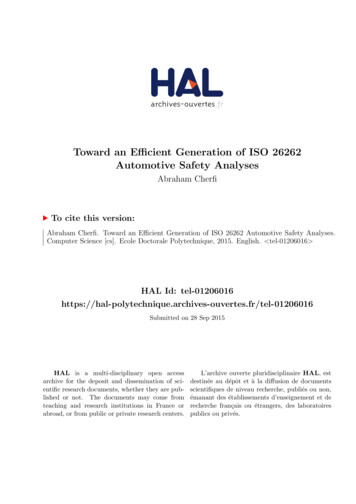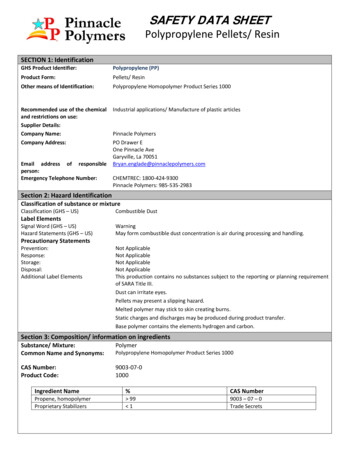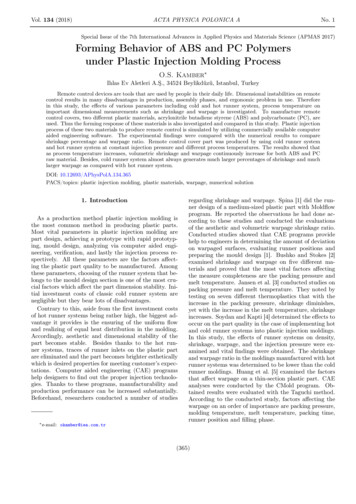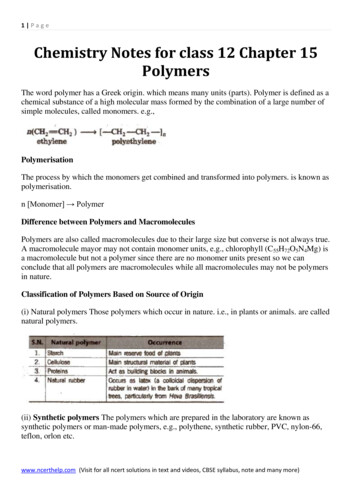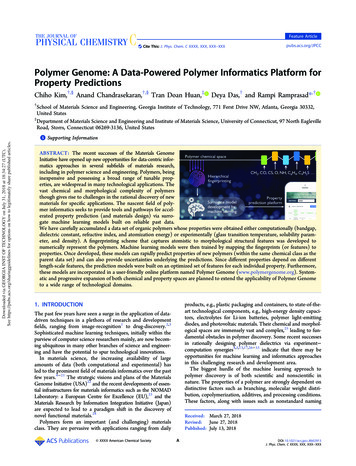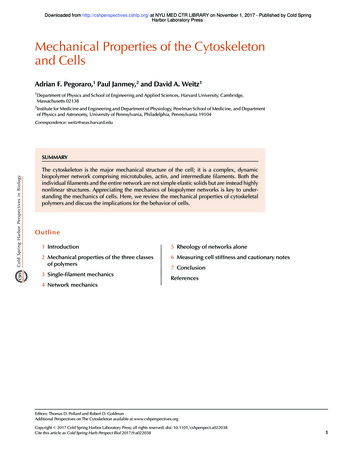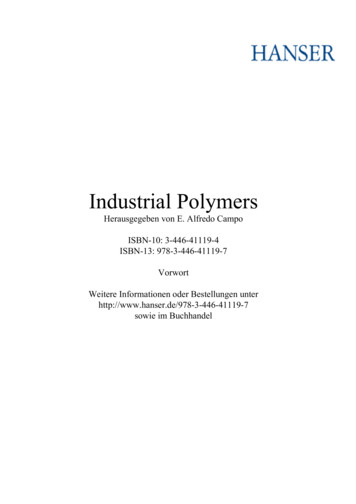
Transcription
Industrial PolymersHerausgegeben von E. Alfredo CampoISBN-10: 3-446-41119-4ISBN-13: 978-3-446-41119-7VorwortWeitere Informationen oder Bestellungen unterhttp://www.hanser.de/978-3-446-41119-7sowie im Buchhandel
VIIPrefaceIndustrial Polymers provides an in depth look at the most frequently used thermoplastic, thermoplastic elastomers, liquidinjection molding silicone and thermoset polymers found in plastic products today. Virtually every industry uses plasticsin one form or another. The transportation, electronics, construction, medical and aircraft industries rely on plastics toprovide a higher quality product at lower cost than conventional materials, such as metals, wood, concrete or rubber.This book includes descriptions of basic polymer characteristics, diagrams showing the chemical structure of the resin,advantages and disadvantages associated with the use of the polymer and color illustrations showing applications andend use products.Industrial polymers are true man made materials. Their structure is based on chemical elements such as carbon, oxygen,hydrogen, nitrogen, chlorine and sulfur. These elements are extracted from the air, water, gas, oil, coal, and even from livingplants. It was man who took these elements and combined them through various chemical reactions to create an almostunending series of combinations to produce the wide variety of polymers known today as plastics.Many polymers were created as a substitute for materials that were in short supply, such as rubber, wood and metal.The very first “plastic” was invented as a result of a contest offering a 10,000 reward for a patentable material to replacethe ivory used in billiard balls. Although this prize was never awarded, the result was the invention of cellulose nitrate(celluloid), which is still in use today.With over 26,000 polymer compounds available today, it can be an overwhelming task to select the optimum polymer forthe application at hand. Industrial Polymers was written to provide plastics engineers and product designers with a quickand comprehensive reference for selecting a polymer for a particular application.Chapter 1 A brief history of plastics and their evolution into the polymers in use today is explored. The differences amongthe polymer families are explained, including their characteristics, performance and processing conditions.Chapter 2 A description of the most widely used thermoplastic polymers is given, including chemical, thermal, mechanical,processing and wear characteristics. Advantages and disadvantages of using the polymer for a particular application aregiven, as well as, various end uses for the polymer.Chapter 3 Provides information on melt processible rubber (MPR), thermoplastic polyurethane elastomers (TPU),styrenic block copolymer (TPE), polyolefin thermoplastic elastomers (TPO), and various others.Chapter 4 Includes information on liquid injection molding silicone (LIM ). Equipment requirements, injection moldingmachine changes for using LIM and mold modifications are all discussed.Chapter 5 Covers the thermoset polymers which are widely used in the plastics industry. Because of their chemicalstructure, they require different processing techniques and can not be recycled like the thermoplastics.
Industrial PolymersHerausgegeben von E. Alfredo CampoISBN-10: 3-446-41119-4ISBN-13: 978-3-446-41119-7LeseprobeWeitere Informationen oder Bestellungen unterhttp://www.hanser.de/978-3-446-41119-7sowie im Buchhandel
172Polymeric er (ABS)Chemical Structure of ABSHHHHHHHHCCCCCCCCH CNAcrylonitrilenHHn1ButadieneH C 6 N6n2StyreneGeneral Properties of ABSType of polymerSpecific gravityTensile modulus @ 73 F (Mpsi)Tensile strength @ yield (kpsi)Notch Izod impact @ 73 F (ft-lb/in)Thermal limits service temp. ( F)Shrinkage (%)Glass trans. temperature, Tg ( F)Vicat point temperature ( F)Process temperature ( F)Mold temperature ( F)Drying tempe x, and the otheris a copolymer resin with better processing characteristics and impactresistance.
232.2 Acetal (POM, Polyacetal)2.2.1 Advantages of AcetalxHigh mechanical properties, tensile strength, rigidity, and toughnessxGlossy molded surfacesxLow static and dynamic coefficients of frictionxRetains electrical and mechanical properties up to 230 FxLow gas and vapor permeabilityxApproved for applications used in contact with foodxExcellent chemical resistance to common hydrocarbons, aldehydes,ketones, alcohols, and fuels2.2.2 Disadvantages and Limitations of AcetalxPoor resistance to acids and basesxHigh mold shrinkagesxSubject to UV degradation, if special acetal grades are not usedxFlammable (UL-94 HB)xExcessive process melt temperatures over 450 F can result in significantthermal degradation of the material, with the release of formaldehydegasesxViolent thermal degradation (explosion) if acetal melt is contaminatedwith PVCxDifficult to bond when the acetal surface is not treatedFigure 2-11 Needle-bearing liners2.2.3 Typical Applications of AcetalxIndustrial: Conveyor links and slats, cams, bearings, wear stops, hoseconnectors, valve bodies, pumps (housings, pistons, valves, and impellers)and gears.xAutomotive:– Fuel handling systems: Filler caps, level sensors, floats, pumps, andreservoirs– Trims: Seat belt buckle housings, window cranks, shift lever handles,knobs, buttons, mounting clips, visor mounting brackets, levers,exterior door pulls, mirror housings, brackets, bumper strip endplugs, and antenna bases– Instrument panel components: Cluster gears, bearings, housings,cable connectors, slide plates, and panel locks– Under the hood components: Fans, fan blades, snap-fitting housings,and tubing connectorsFigure 2-12 Worm gear motor
242 Polymeric MaterialsxAppliances:– Refrigerators: Shelving clips, brackets, bearings, and gears– Washers and dryers: Gears, bearings, wear strips, instrument housings,and hose connectors– Dishwashers: Rack rollers, spray nozzles, soap dispensers and filtersupportsxHome Electronics:– Keyboards: Key caps, plungers, guides, and base plates– Telephones: Push buttons, gears, bearings, and springs– Modular components: Clips, peg boards, connectors, wear strips fordrawers, latch springs, and clamps– Audio and video DVD players and recorders: Tape hubs, guide rollers,cams, gears, bushings, and bearingsxPlumbing:– Water meters: Housings, cams, gears, dials, and pressure plates– Faucets: Underbodies, cartridges, stems, packing nuts, and waterways– Water softeners: Pump housings, pistons, impellers, and valves– Filters: Bodies, plates, and screens– Pressure regulators: Bodies, stems, knobs, and pressure plates– Potable water distributors: Fittings, drain valves, stop valves, andmetal pipe adaptersxConsumer:– Personal care: Mascara, perfume, and deodorant containers, combs,aerosol valves, soap dispensers, and cosmetic applicator handles– Small appliances: Motor gears, cams, bearings, pumps, glue applicators, housings, and springs– Toys: Shells, frames, gears, bearings, cams, springs, wheels, andconnectors– Sporting goods: Ski bindings, gears, bearings, guides, wear plates,clamps, pump components, valves, and bucklesxHardware: Drapery and Venetian blind guides, hangers, rollers, bearings,furniture casters, slide plates and locks, tool holders, bearings, gears, andhousingsxIrrigation: Sprinkler nozzles, arms, gears, housings, waterways, pumphousings, impellers, pistons, metering valve bodies, knobs, stems, andinternal componentsxAgriculture: Shift levers and housings, hydraulic connectors, bearings,gears, and seed application disksFigure 2-13 Automotive fuel level sensorFigure 2-14 Gas tank cap with overridecamsFigure 2-15 Automotive end ball jointbearing
injection molding silicone and thermoset polymers found in plastic products today. Virtually every industry uses plastics in one form or another. The transportation, electronics, construction, medical and aircraft industries rely on plastics to . Acetal resins provide a well-balanced set of properties including a hard self-lubricated surface .



